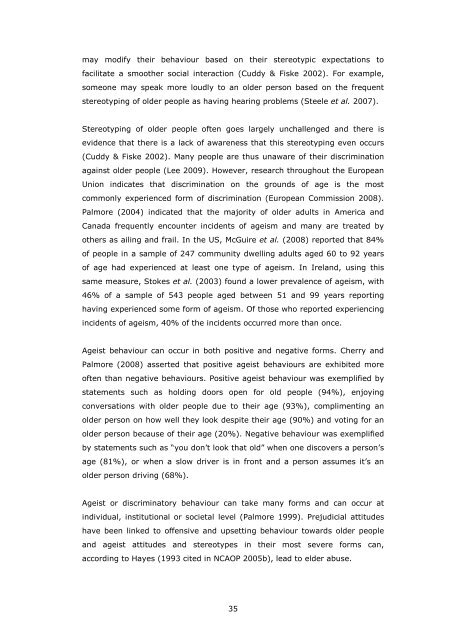Public Perceptions of Older People A literature review
Review 1 PP OP.pdf - National Centre for the Protection of Older ...
Review 1 PP OP.pdf - National Centre for the Protection of Older ...
Create successful ePaper yourself
Turn your PDF publications into a flip-book with our unique Google optimized e-Paper software.
may modify their behaviour based on their stereotypic expectations to<br />
facilitate a smoother social interaction (Cuddy & Fiske 2002). For example,<br />
someone may speak more loudly to an older person based on the frequent<br />
stereotyping <strong>of</strong> older people as having hearing problems (Steele et al. 2007).<br />
Stereotyping <strong>of</strong> older people <strong>of</strong>ten goes largely unchallenged and there is<br />
evidence that there is a lack <strong>of</strong> awareness that this stereotyping even occurs<br />
(Cuddy & Fiske 2002). Many people are thus unaware <strong>of</strong> their discrimination<br />
against older people (Lee 2009). However, research throughout the European<br />
Union indicates that discrimination on the grounds <strong>of</strong> age is the most<br />
commonly experienced form <strong>of</strong> discrimination (European Commission 2008).<br />
Palmore (2004) indicated that the majority <strong>of</strong> older adults in America and<br />
Canada frequently encounter incidents <strong>of</strong> ageism and many are treated by<br />
others as ailing and frail. In the US, McGuire et al. (2008) reported that 84%<br />
<strong>of</strong> people in a sample <strong>of</strong> 247 community dwelling adults aged 60 to 92 years<br />
<strong>of</strong> age had experienced at least one type <strong>of</strong> ageism. In Ireland, using this<br />
same measure, Stokes et al. (2003) found a lower prevalence <strong>of</strong> ageism, with<br />
46% <strong>of</strong> a sample <strong>of</strong> 543 people aged between 51 and 99 years reporting<br />
having experienced some form <strong>of</strong> ageism. Of those who reported experiencing<br />
incidents <strong>of</strong> ageism, 40% <strong>of</strong> the incidents occurred more than once.<br />
Ageist behaviour can occur in both positive and negative forms. Cherry and<br />
Palmore (2008) asserted that positive ageist behaviours are exhibited more<br />
<strong>of</strong>ten than negative behaviours. Positive ageist behaviour was exemplified by<br />
statements such as holding doors open for old people (94%), enjoying<br />
conversations with older people due to their age (93%), complimenting an<br />
older person on how well they look despite their age (90%) and voting for an<br />
older person because <strong>of</strong> their age (20%). Negative behaviour was exemplified<br />
by statements such as “you don’t look that old” when one discovers a person’s<br />
age (81%), or when a slow driver is in front and a person assumes it’s an<br />
older person driving (68%).<br />
Ageist or discriminatory behaviour can take many forms and can occur at<br />
individual, institutional or societal level (Palmore 1999). Prejudicial attitudes<br />
have been linked to <strong>of</strong>fensive and upsetting behaviour towards older people<br />
and ageist attitudes and stereotypes in their most severe forms can,<br />
according to Hayes (1993 cited in NCAOP 2005b), lead to elder abuse.<br />
35









